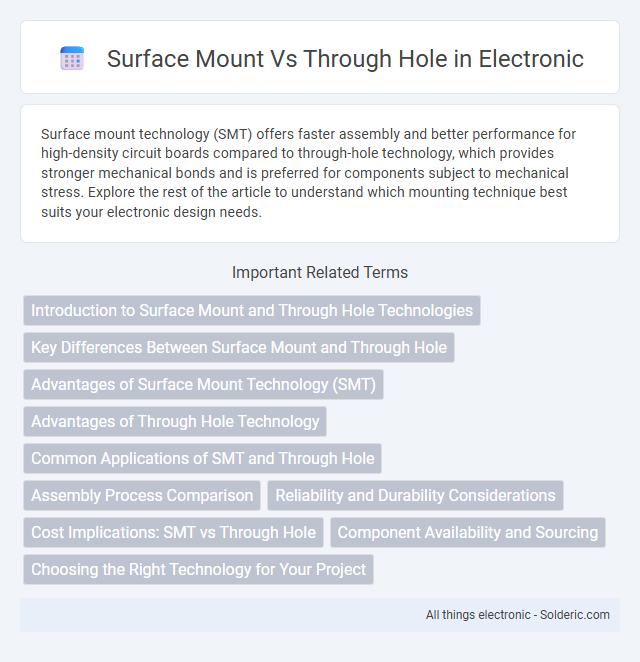Surface mount technology (SMT) offers faster assembly and better performance for high-density circuit boards compared to through-hole technology, which provides stronger mechanical bonds and is preferred for components subject to mechanical stress. Explore the rest of the article to understand which mounting technique best suits your electronic design needs.
Comparison Table
| Feature | Surface Mount Technology (SMT) | Through Hole Technology (THT) |
|---|---|---|
| Component Size | Small, compact | Larger, bulkier |
| Assembly Process | Automated, faster | Manual or automated, slower |
| Mounting Style | Mounted directly on PCB surface | Leads pass through PCB holes |
| Electrical Performance | Lower inductance and resistance | Higher inductance and resistance |
| Mechanical Strength | Less mechanical strength | Stronger mechanical bonding |
| Cost | Lower production cost in volume | Higher cost due to labor |
| Repair and Prototyping | Harder to repair manually | Easier to replace and prototype |
| Application | Modern electronics, high-density boards | Power electronics, connectors, prototypes |
Introduction to Surface Mount and Through Hole Technologies
Surface mount technology (SMT) involves mounting electronic components directly onto the surface of printed circuit boards (PCBs), allowing for more compact and efficient designs. Through hole technology (THT) requires inserting component leads into pre-drilled holes on the PCB, providing stronger mechanical bonds ideal for high-stress applications. Understanding these differences helps you select the appropriate method based on your project's size constraints, durability needs, and assembly process.
Key Differences Between Surface Mount and Through Hole
Key differences between surface mount and through hole technology lie in their mounting techniques and applications; surface mount devices (SMDs) are soldered directly onto the PCB surface, enabling higher component density and automated assembly. Through hole components have leads inserted into drilled holes on the PCB, providing stronger mechanical bonds ideal for high-stress environments and prototyping. Your choice depends on factors such as production volume, mechanical durability requirements, and circuit complexity.
Advantages of Surface Mount Technology (SMT)
Surface Mount Technology (SMT) offers significant advantages, including higher component density allowing for more compact and lightweight designs. SMT enables faster and more efficient automated assembly processes, reducing production time and costs. Your electronic devices benefit from improved electrical performance and reliability due to shorter lead lengths and reduced parasitic elements.
Advantages of Through Hole Technology
Through hole technology offers superior mechanical strength and reliability due to its leads passing through the PCB, making it ideal for components subjected to mechanical stress or high power applications. It ensures better thermal dissipation and easier inspection or repair, enhancing overall durability and serviceability of your electronic assemblies. This makes through hole technology advantageous for prototypes, heavy-duty components, and environments requiring robust connections.
Common Applications of SMT and Through Hole
Surface Mount Technology (SMT) is widely used in high-density applications such as smartphones, laptops, and modern consumer electronics due to its compact size and automated assembly process. Through Hole Technology (THT) is preferred for applications requiring strong mechanical bonds and durability, including automotive electronics, industrial machinery, and aerospace equipment. Both SMT and THT serve critical roles in PCB manufacturing, with SMT optimizing space and speed, while THT ensures reliability in rugged or high-stress environments.
Assembly Process Comparison
Surface mount technology (SMT) allows for automated component placement and soldering on both sides of a printed circuit board, resulting in faster assembly and higher component density. Through-hole technology requires manual or selective soldering of component leads inserted into drilled holes, increasing labor time and limiting compact design flexibility. SMT offers superior efficiency and speed in mass production, while through-hole assembly provides stronger mechanical bonds for components subjected to mechanical stress.
Reliability and Durability Considerations
Surface mount technology (SMT) generally offers superior reliability due to smaller solder joints that reduce mechanical stress and improve thermal performance compared to through-hole components. Through-hole mounting provides enhanced mechanical strength for connectors and components exposed to physical stress, making it suitable for high-vibration environments. Durability in SMT is often improved by advances in solder paste and reflow processes, while through-hole connections remain favored for their robustness in heavy-duty and high-reliability applications.
Cost Implications: SMT vs Through Hole
Surface Mount Technology (SMT) generally offers lower overall production costs due to automated assembly processes and reduced material usage compared to Through Hole Technology (THT). While THT components often have higher per-unit costs and require more labor-intensive soldering, SMT enables higher component density and faster manufacturing cycles, which significantly reduces labor and time expenses. The initial investment in SMT equipment can be higher, but cost savings accumulate in large-scale production, making SMT more economical for mass manufacturing.
Component Availability and Sourcing
Surface mount components offer a broader selection due to widespread use in automated manufacturing, making them more readily available and often cost-effective for high-volume production. Through hole components remain easier to source for specialized or legacy designs, favored in applications requiring enhanced mechanical strength or manual assembly. Your choice of component type impacts sourcing flexibility, cost, and availability, especially when balancing modern electronics demands versus traditional manufacturing.
Choosing the Right Technology for Your Project
Choosing between surface mount and through hole technology depends on your project's size, complexity, and production volume. Surface mount components offer compact design, faster assembly, and are ideal for high-density circuits, while through hole components provide stronger mechanical bonds, suitable for prototypes and devices requiring durability. Evaluating the balance between assembly efficiency and mechanical strength ensures you select the right technology for your project's specific needs.
surface mount vs through hole Infographic

 solderic.com
solderic.com